As the winter weather sets in we have quite a few plants in our garden in bloom so I hope you do too. However our time in the garden may be interrupted by rain so here’s a big and varied newsletter for you to sit down and read and admire all the articles and photos that different members have contributed. Enjoy.
Plant of the Month – January
Back at the start of the year I was impressed to receive some photos from member Daavid Turnbull of a magnificent Doryanthus palmeri (Giant spear lily) in his garden.


February Meeting
Much travelled committee member Verena Reich was our speaker. She spoke about her trip to Lord Howe Island, a place not many of us travelled to. Due to a camera omission from her suitcase Verena relied on photos from fellow travellers for her presentation. Verena has kindly written a precis of her talk and for those who missed it there are a few photos too. Thanks Verena.

‘A much-postponed trip (thank you COVID) finally happened – 21 Friends of Royal Botanic Gardens Cranbourne spent 8 days on this little island, ably guided by Ian Hutton, an expert in all things Lord Howe Island-related. The island is World Heritage listed, The short talk described what we saw and learned about this fabulous place.

Lord Howe Island is about 700 km north-east of Sydney and south-west of Brisbane. It is the remnant of a volcano that erupted over 6 million years ago, and has eroded to about 2.5% of the original land mass. Of the total area of about 1450 hectares, approximately 75 percent of the island’s original natural vegetation remains intact and undisturbed. Likewise, its beaches, coral reef and marine environment are pristine.

The island’s isolation and its varied landscape of mountains, valleys, hills, lowlands and sea-cliffs have resulted in a diverse array of habitat types supporting many distinctive flora and fauna assemblages. Vegetation ranges from exposed coastal grasses and heath to luxuriant mossy rainforest shrouded in mist. Many sea birds visit to breed. This is one of the “cleanest” places on earth, with no air or sea pollution or litter. Of the 220 species of plants, about half are endemic – plants such as the Kentia Palm (Howeana forsteriana and the Banyan (Ficus macrophylla subspecies columnaris).

There are about 380 permanent residents and a maximum of 400 tourists at any one time.
In 1982, The Lord Howe Island Group was listed as a UNESCO World Heritage property, in recognition of the global significance of the island’s beauty and biodiversity.

Uninhabited until after 1788, humans brought about extinctions and near-extinctions through the introduction of foreign animals, birds and plants. However, with strict bio-security and eradication of feral animals, particularly black rats, there are some success stories for threatened species such as the Lord Howe Island Woodhen (from less than 30 in the late 1970’s to 1,147 in 2023). ‘

Plant of the Month – February
This lovely Alyogyne hakeifolia from our garden provides the plant of the month. Pleased to say Karen grew it from a cutting from the plant table several years ago.
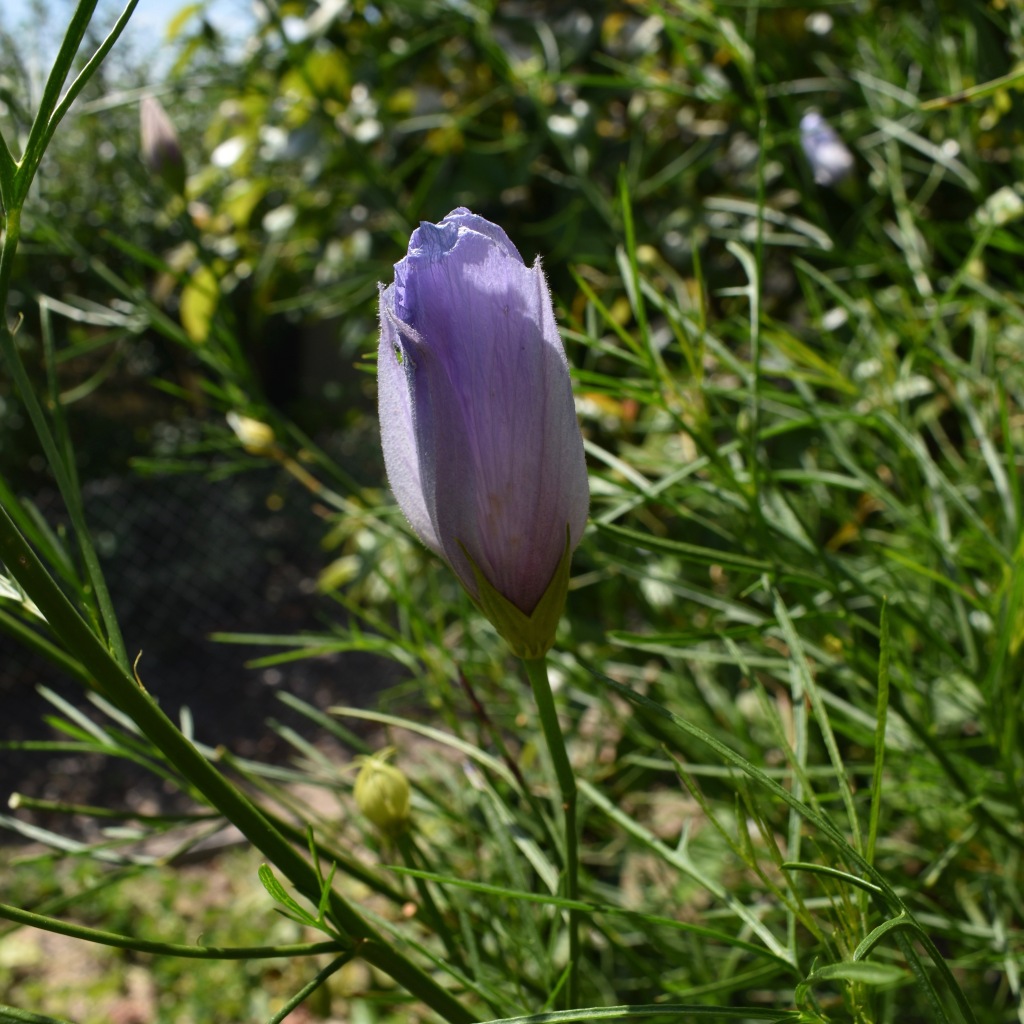
March Walk – Endeavour Fern Gully, Red Hill
Sunday 5th March saw a large group join in on the walk through Endeavour Fern Gully at Red Hill. Entry is via a gate as the area is under the care of the National Trust.

Initially the walk started with a descent.

After a while we came to the fern gully area.

Here the walk followed a wooden boardwalk.

The walk was well sign boarded with lots of information and diagrams. Two types of tree ferns could be seen.

Lots to see, some quite unusual.

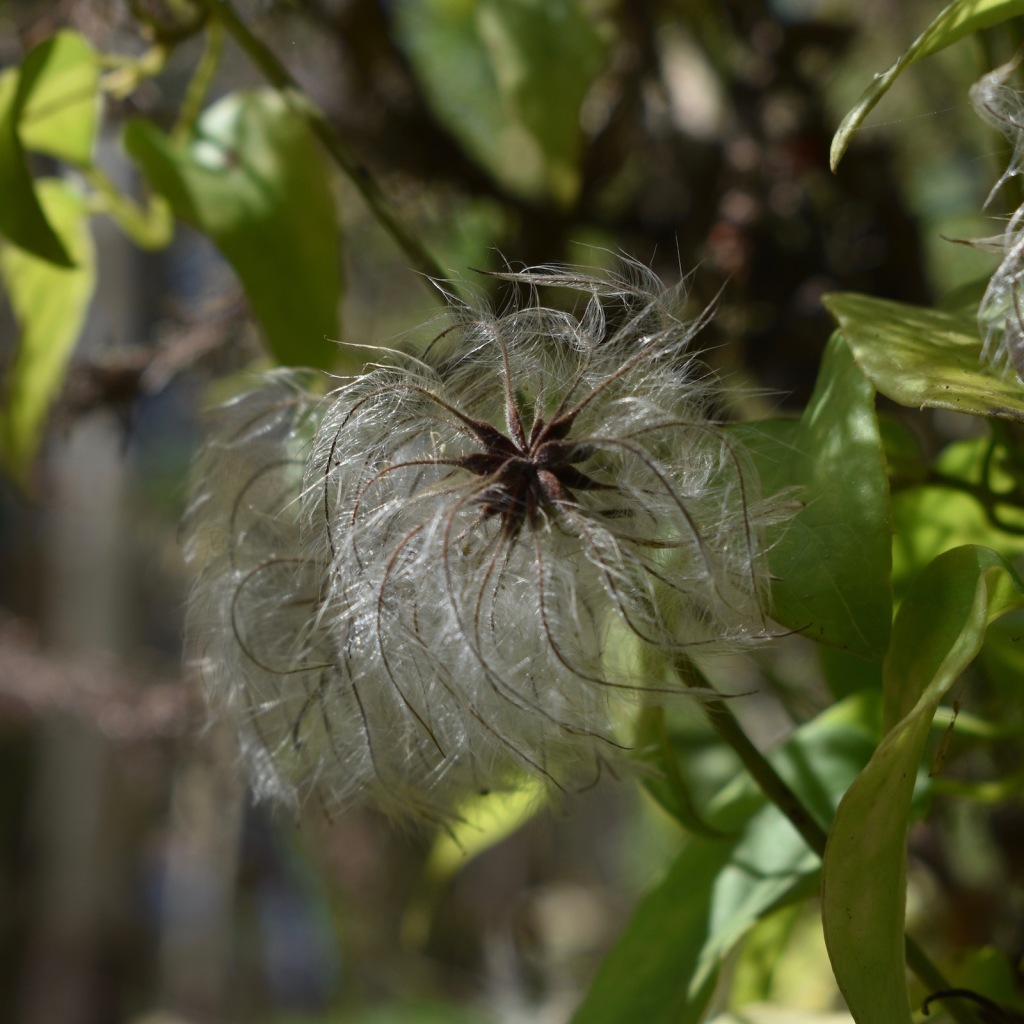
Plant of the Month – March
Leader, Robyn Tyson was very pleased to send me a stunning photo of her Rhododendron lochiae in March. It belongs in the mountainous rainforests of Queensland but Robyn has convinced it to grow in a pot which she purchased back in 2020. It’s in an open shady spot and this is the first year it has flowered.

March Meeting
Leanne Scott was our speaker for the March meeting at Benton’s Square Community Centre. She spoke about her recent work at the Briars but a large part of her talk was devoted to her time working in the field of plant genetics. Fascinating.
March Plant Table
Here’s a small selection of some of the beautiful flowers seen on our March Plant Table.





Revegetation at Devil Bend
Prior to Covid lockdowns a number of our members joined in on a planting day at Devilbend. On a walk Robyn Tyson took a couple of snaps to show how well the plants are going. Thanks Robyn.


April Walk – Balbirooroo Wetlands, Balnarring
A small group met on Tuesday 4th April at Balbirooroo Wetlands in Balnarring. The weather was kind to the group who saw a few water birds and frogs but not much was in flower. Here’s a photo of the information board there.

April meeting
Due to school holidays this meeting was held via Zoom. About 20 screens with 25 members joined in to hear and see a very interesting talk entitled Raising Rarity presented by Dr Megan Hirst.
She is a Seed Ecologist at Royal Botanic Gardens Victoria and shared details of this conservation engagement strategy incorporating community, conservation and commercialisation to protect Victorian threatened plant species from extinction. She emphasised how important conservation horticulture is and the work with students helps greatly to continue extend this knowledge to future generations. Plants used in this important work which she highlighted included Brachyschome tadgellii (White alpine daisy), Rutidis leptorhynchoides (Yellow button wrinklewort), groundcover Lobelia gelida (Snow Pratia), Craspedia carens (Grey Billy Buttons) and Xertochrysum palustre (Swamp everlasting – which suits boggy sites).
Care for Rare
In keeping with the theme of our April meeting, leader Robyn Tyson sent me these photos of her rare Grevillea bedggoodiana. She bought it at a Cranbourne sale last October. She has it in a pot.

Even though it is past it’s best whilst flowering it’s worth taking a look. Thanks for sharing Robyn.

Seaford Banksia Arboretum
Several plantings have occurred at the Seaford Banksia Arboretum. Convenor, Ross Shepherd reports that at the start of April a small group planted 45 Banksias on the big incline of lot 1 in rows of 6 or 7. They included B. Sceptrum, B. Canei, B. Quercifolia, B. Illicifolia, B. Intergifolia var Monticola, B. Seminuda, then a B. Blechnifolia, a couple more B. Baueri and B. Oreophila, a B. Telmatiaea and they replaced a lost B. Serrata. Luckily the rain stayed away too. Then we used Chris Long’s post hammer to drive in many garden stakes around the swamp area in an attempt to keep the mower man out of there. More were planted out after Easter. If you wish to be involved the next activity is a site clean up, weeding and mulching day on Saturday 17th June.
Thanks all, Ross Shepherd

Plant of the Month – April
Here’s another Banksia for you to see. Our garden produced this lovely Banksia menziesii cone in April. The plant is in a good spot on top of a retaining wall and is about five years old.

Plant Sale
Jenny Bolger, Leader of the Plant Sale Organising Sub-Committee has sent me a detailed report. Once again it was a great chance to find something different for our gardens or just replace something that didn’t like all the rain last year.
‘Hi everyone
Our sale on Saturday was the most successful to date, helped by great weather (apart from that one shower!), a huge publicity effort, and the location. Our wonderful volunteers meeting and greeting the visitors logged 729 attendees, so I think we could quite safely say we had around 750 people attending by time a few people slipped through the net! We signed up 33 new members – and that was really without much arm-twisting… they were coming to us! I don’t have the book sales final stats, but trade there was brisk.

Thanks everyone, particularly the Plant Sale sub-committee, for your efforts in the planning, executing, volunteering on the day etc. The growers were delighted (Kay Pitt from Sunvalley was out on Sunday morning propagating plants for our next sale!) – and both Melaleuca and Phil Vaughan reported that they did better than at the Geelong APS Sale, which is quite something.

Thanks so much for the collection of this data – it’s really helpful for our planning for next year.

The plant specimen table was very popular with lots of interested people gathering around it. There was a very ‘speccy’ red Grevillea labelled as Grevillea Goliath – does anyone know who brought it?.. I think it was originally bought from Rod Pitt (Sunvalley), but his “mother” plant died a few years ago, and he’d love to try to propagate from whoever has it growing in their garden. Please let me know if you can solve the mystery!

I hope you all managed to add to your plant collection.’


May meeting
Geoff Lay visited us and spoke on Bushfire Recovery. Thanks to Secretary Jacqui Oldham for the report.
‘Geoff Lay, a 40+ year member of Maroondah APS and 52+ year bush walker gave the talk on Bushfire Recovery, informed by his experience of both. He showed images of Wilson’s Promontory and the Grampians taken at the same sites at intervals of over 15 years of observation after fire.
From 2003-2009, Wilson’s Prom burnt twice – once at each end, the Grampians three times , the Alps once and most of the rest of Victoria once.
He described 3 types of environs-
Grassland- basically now farmland, that’s amenable to cool mosaic burns
Woodland- spaced out trees with non continuous canopy
Forest- home of the mountain ash – the tallest flowering plant in the world.
He showed some of the surprising sequence of after effects-
1. The ‘vacuum cleaner’ effect- nothing on the ground, even rocks burn and crack. Yet almost immediately, bright orange fungus fruits – “from the end of a burning log”- Pyronema omphalodes , dormant for years until triggered by fire. At two months , so long as there is some rain, fungus is everywhere.
2. Heat and smoke cause seed release -many natives need only this eg Hakea decurrens
3. Moss- the first green eg funaria hygrometra
4. Monocots – those with one leaf on a stem- grasses, and Ferns – eg tree ferns
5. Flowering plants- Dicots- a distant third. By 6 months after fire – Wahlenbergia, by 8 months Kennedia , Kangaroo Apple.
Eucalypts need fires and burn well because of the oil, but recover with epicormic growth where new leaves sprout from the blackened trunk and sides of branches creating bright orange red fluffy balls – a photographic explosion of colour in a denuded landscape. The eucalypts with lignotubers sprout from the base.
Some plants only flower after fire eg. Lobelia rhombifolia, Pyrorchis nigricans, and Diplarena moreii.
The first spring after fire is a spectacular vision of hundreds of flowers now open to the sun. Grass trees suddenly all flower in one season- striking white poles . In the Grampians , they were 7-8m tall. They then blacken and fall till the next fire. A bonus of fire at the Prom, is that Leptospermum lanigerum, which had become a weed, has not regrown as it’s seed burns with it.
Importantly, no seed will survive 2 fires.
The natural cycle of fire at the Prom is roughly every 7 years – longer in the Alps. Alpine ash requires 15 years to grow to seed. Generations will be required to see that forest as it was. Rainforest will probably not survive – but in discussion after the talk it was noted that Nothofagus, the ancient beech has been observed to be growing after much delay in some sites.
May Plant Table
Thanks to those who brought plant samples to share on the plant table. Here’s a few that caught our eye.
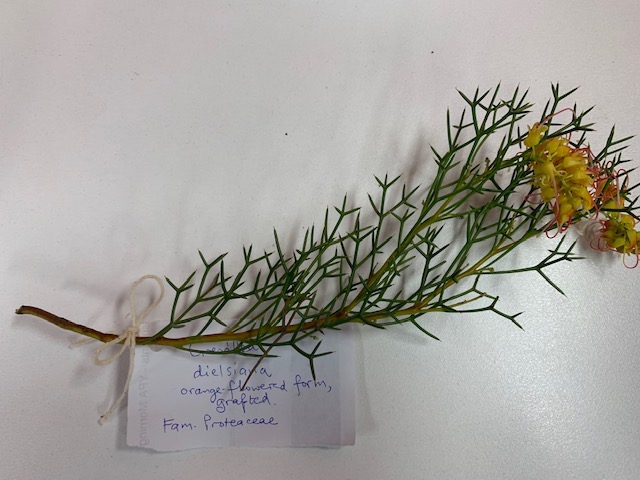
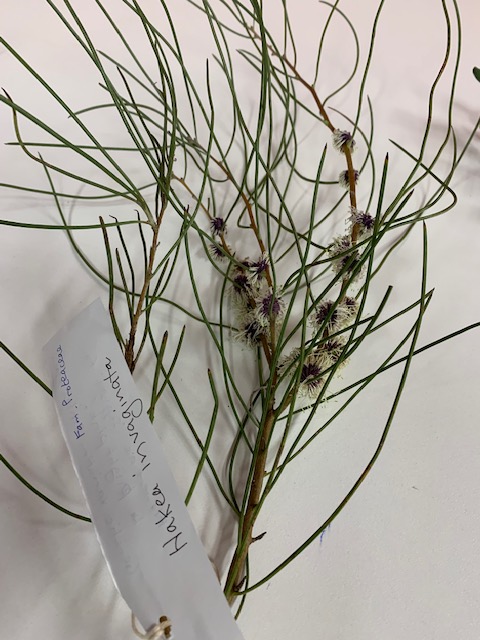


May Walk – Bunarong Reserve, Frankston
Thirteen members joined leader Robyn Tyson for the walk at Bunarong Reserve in Frankston.


A stand out were all the Acacia suaveolens in bloom.

The first part of walk was uphill to the lookout near the large water tank. Great views.

The trail was grey sand and easy to follow.

The walk descended for a while.
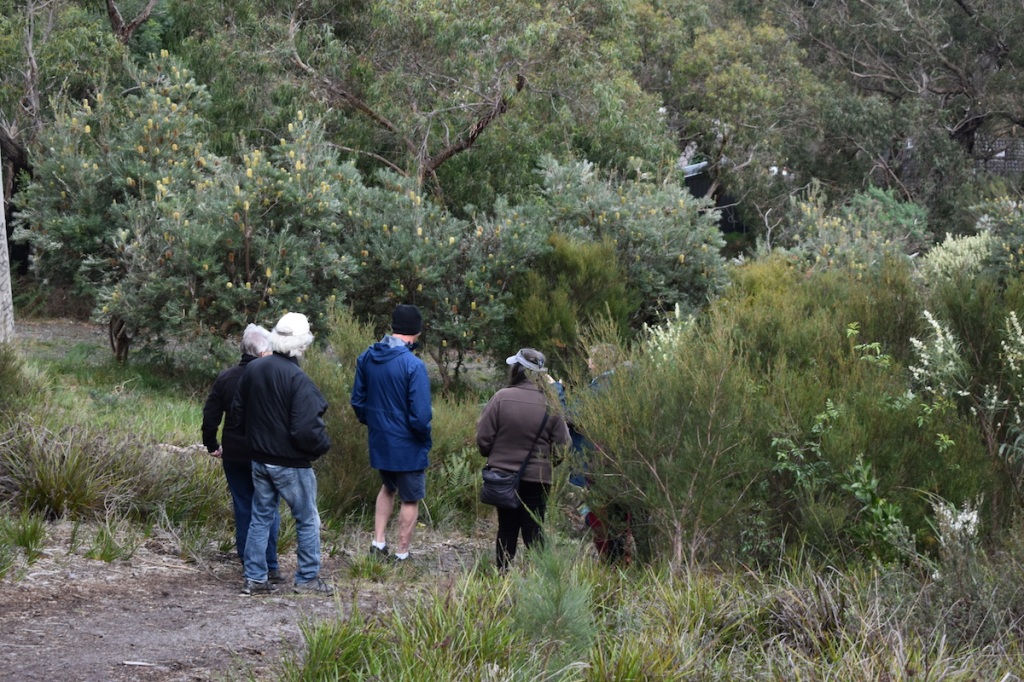
We weren’t the only ones checking out the Banksias.

Some Allocasuarina were in flower but more impressive were all the seed pods.

The second part of the walk took us along the Wedding Bush Way.

There was lots of Heath, Epacris impressa, in bloom – quite a few shades of pink.

Correas too.
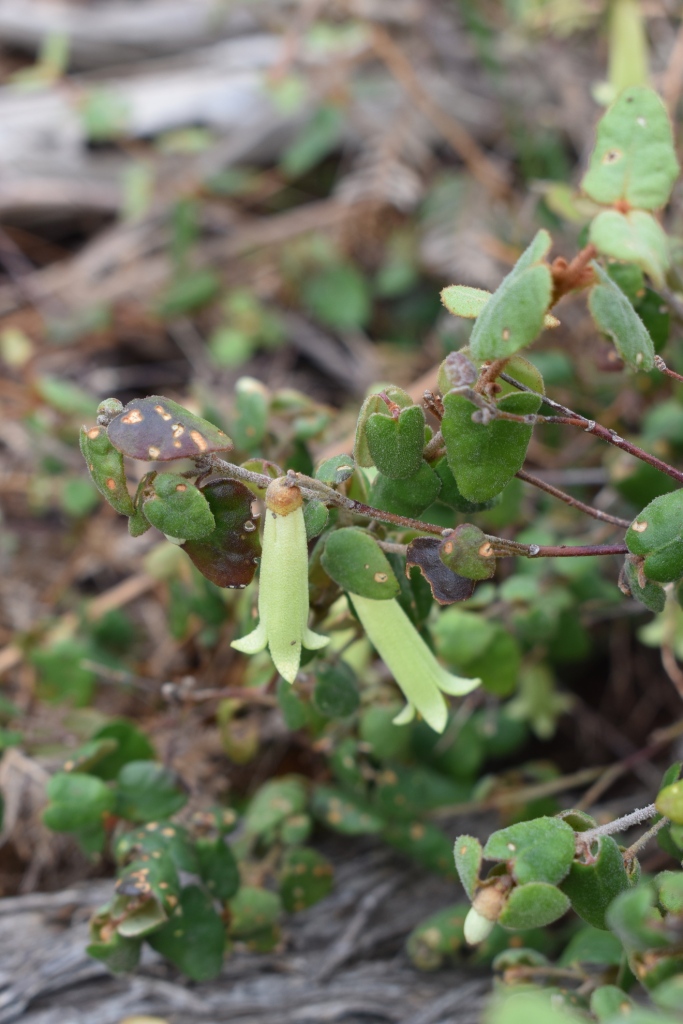
It’s a lovely walk which would have something different to offer in each season.
Plant of the Month – May
Member Roo Rawlins sent me photos of her Kangaroo Paws which were on show during May in her garden. The yellow one is Anigozanthos Gold Velvet which is about 1m.

Regal Velvet (appropriate with Coronation!) same size, both are still flowering.

Plant of the Month – June
Our Hakea laurina has been providing a beautiful display this month. The bees and the wattle birds have been regular visitors.

Our next meeting is on June 20th and guest speaker Chris Larkin will be presenting on Hakeas. So if you have a Hakea blooming in your garden presently bring a cutting to share for the plant table. Chris has also extended an invitation to our group to visit her garden in Lysterfield on Sunday June 25th at 1:30pm.
Hope you have enjoyed our bumper newsletter.
Editor, Mark Allison
